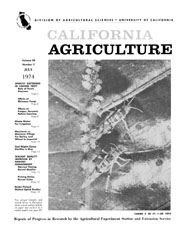


University of California
California Agriculture
|
|||
|
|||

Cover:
Two winged females and several larvae of European dusky-veined walnut aphids on upper leaf surface of a walnut leaflet.
July 1974
Volume 28, Number 7 News and opinion |
|||
|
University of California, 1301 S. 46th St., Bldg. 478 Richmond, CA
|